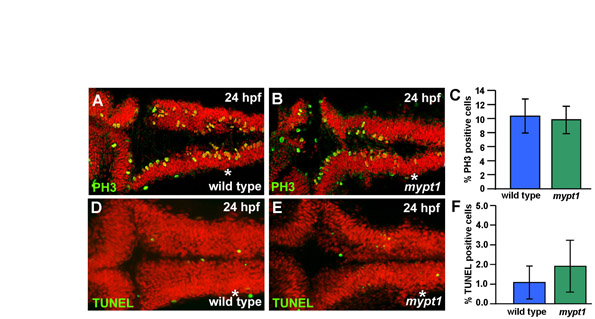Fig. S4 Cell proliferation and cell death are normal in the hindbrain of mypt1 mutants. Phospho-histone H3 (PH3) labeling was conducted as previously described (Lowery and Sive, 2005). Apoptosis was detected by the TUNEL method using the Apoptag Kit (Chemicon) according to the provided protocol using fluorescent detection of apoptotic cells. Embryos were counterstained with propidium iodide to label nuclei and imaged by laser-scanning confocal microscopy (Zeiss LSM510). (A,D,B,E) Wild type (A,D) and mypt1 mutants (B,E) were stained for PH3 or TUNEL (green) and the nuclei were counterstained with propidium iodide (red). (A) PH3 staining in a 24 hpf wild-type embryo. (B) PH3 staining in a 24 hpf mypt1 mutant embryo. (C) Quantitation of green PH3-positive cells versus total cell number; the data are expressed as the percentage of PH3-positive cells. Wild type, n=6; mypt1, n=6. (D) TUNEL staining in a 24 hpf wild-type embryo. (E) TUNEL staining in a mypt1 mutant embryo. (F) Quantitation of TUNEL-positive cells versus total cell number in wild type and mypt1 mutants; the data are expressed as the percentage of TUNEL-positive cells. Wild type, n=8; mypt1, n=6. Anterior is to the left in all images. There were no significant differences between wild-type embryos and mutants analyzed with either PH3 or TUNEL. Asterisk indicates ear.
Image
Figure Caption
Acknowledgments
This image is the copyrighted work of the attributed author or publisher, and
ZFIN has permission only to display this image to its users.
Additional permissions should be obtained from the applicable author or publisher of the image.
Full text @ Development

